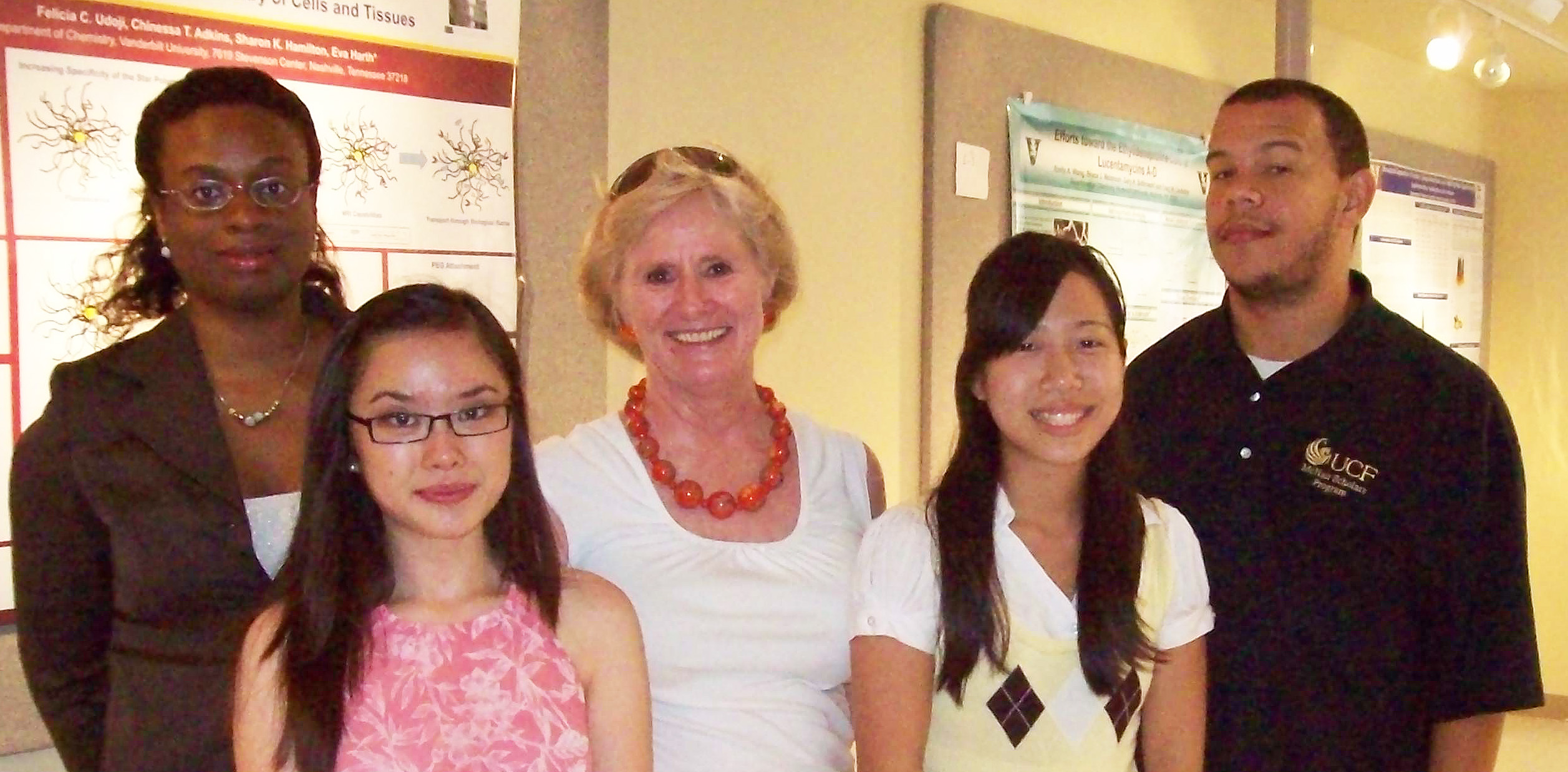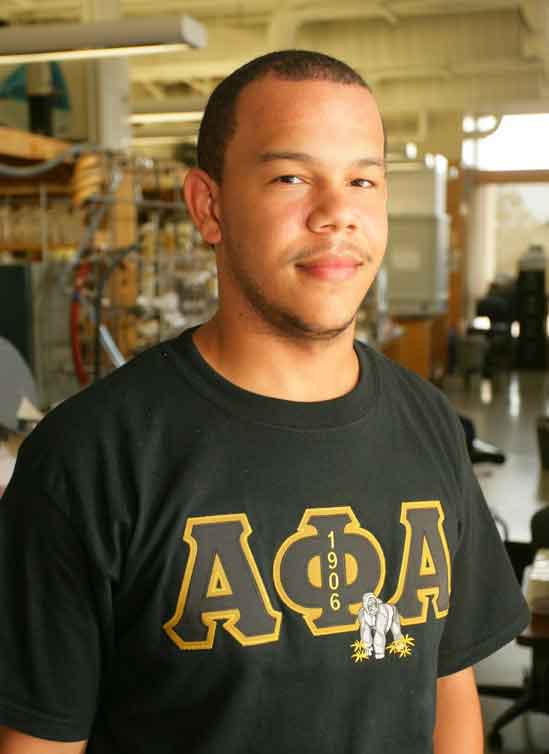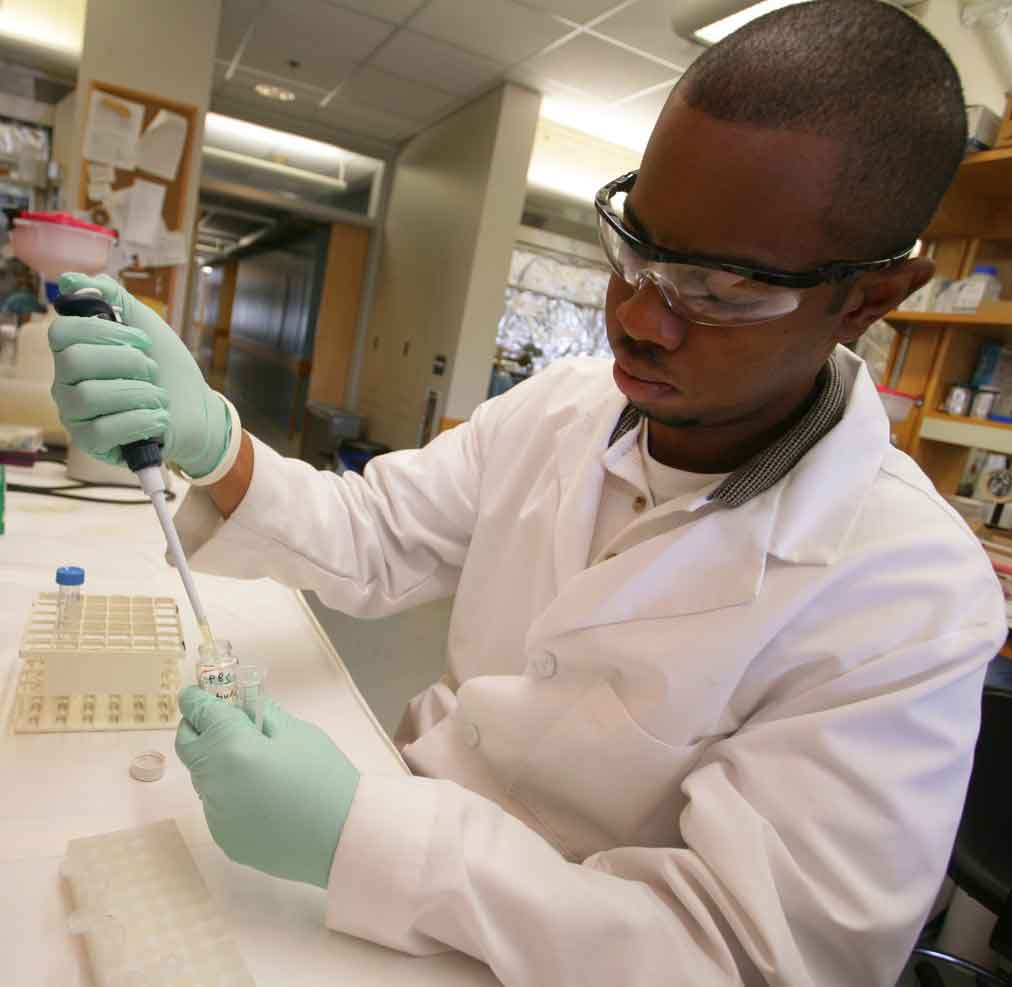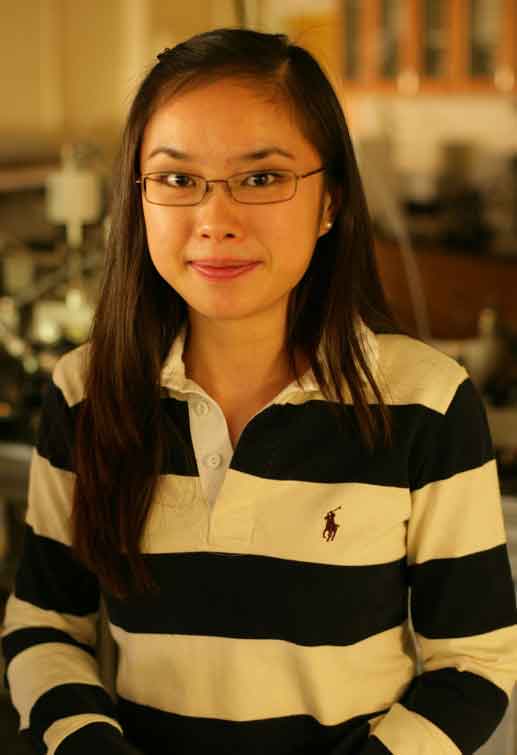2008 Trainees

|
2008 Student Testimonials |
||
2008 REU Students |
||
|
Reid Barnett, King University
|
||

|
Matthew Bryant Research Abstract: Near-infrared fluorescence enhancement was observed upon direct coupling of gold monolayer-protected clusters (Au-MPC’s) to platinum monolayer protected clusters (Pt-MPCs) through a peptide linker. Au-MPCs are known to have intrinsic fluorescence in the near-IR region (em 950-1050 nm), while we report little to no fluorescence for similar Pt-MPCs. Mixing these nanoparticles in solution, each having oppositely charged ligands, leads to overall decreased fluorescence. Directly coupling the nanoparticles through a peptide linker causes an increase in fluorescence intensity randing from 1.5 to 4.5 fold when compared to Au-MPCs , or 12 to 15 fold when compared to quenched Au-MPC/Pt-MPC mixtures. Reaction of the coupled MPCs with the well known protease trypsin yields decreased fluorescence due to cleavage of the peptide linker, and liberation of Pt-MPCs. The current work on these MPCs involves a small molecule linker, preferably a thiol with amine functionality to be used as a linker similar to the peptide to see if a larger increase will be observed in the near-IR. Au-MPC to Au-MPC linkage will also be attempted to see if the fluorescence is due to the Au/Pt interaction. |
|

|
Dain Beezer Research Abstract: HNE (4-hydroxynonenal) is a secondary oxidation product of polyunsaturated fatty acids. This alpha beta unsaturated aldehyde, is very reactive toward nucleophiles such as DNA and proteins. It has been shown to modify proteins that trigger cell signals and alter gene expression pathways responsible for pathogens of some oxidative stress related diseases. In order to better understand the damaging effects of HNE, identification of HNE target proteins is necessary. The selective capture and release of HNE protein adducts using click chemistry and affinity purification have been utilized to identify protein adducts followed by LC-MS/MS. In this study, we develop methods to selectively catch either modified proteins or modified peptides in order to enrich adducts for LC-MS/MS analysis. Alkynylated HNE (aHNE) was added to human plasma and incubated at 37 degrees followed by reduction using sodium borohydride. The reaction mixture was filtered with MWCO=10kd to remove small molecules. The Adducts were then clicked with biotin-azide in the presence of ascorbate, copper sulphate, and ligand. The biotinylated proteins were either immobilized onto streptavidin beads overnight in a cold room then washed with various solutions to remove nonspecific binding proteins (protein catch) or trypsinized in solution followed by streptavidin purification (peptide catch). The washed streptavidin beads were suspended in PBS buffer and exposed briefly to UV light (365nm) to release the adducted proteins or peptides. In the case of protein catch, the photo eluate from the streptavidin beads was resolved by SDS-PAGE. The gel bands were excised and digested with trypsin in gel. The adducts that were prepared from both protein catch and peptide catch were analyzed using LC-MS/MS. The data were searched against a human protein database in Sequest and identified the adducted proteins using ID Picker. Thirty-nine protein groups were identified. Among them human serum albumin (HSA) and Apolipoproteins (ApoA1) were identified to be highly modified with aHNE. In the case of HSA, Michael adducts have been found on H67, H146, and K199. In the case of ApoA1, HNE has been adducted on H162, H193, and H199. Based on this observation, it would be interesting to pursuit further studies of these proteins to explore possible link to oxidative stress related diseases. |
|
|
|
||

|
Charles Johnson
|
|
 |
|
David Lonie
|

|
Tomi Oluwatola
Research Abstract: Advances in the Development of Positive Allosteric Modulators of Metabotropic Glutamate Receptor Subtype 5 (mGluR5). ADX-47273, [(S) - (4-fluorophenyl) (3-(3-(4-fluorophenyl)-1, 2, 4-oxadiazol-5-yl) piperidin-1-yl) methanone], a recent compound of Addex Pharmaceuticals selectively modulates mGluR5 in the presence of an endogenous agonist and thus represents a potential antipsychotic treatment. Over 50 analogues have been synthesized and are being examined for their response to glutamate using fluorometric Ca2+ assays. The analogues were prepared by diversifying aryl groups at two points about an (R) or (S)-3-oxadiazolyl-piperidine scaffold. The compounds were synthesized by EDC amide coupling and subsequent dehydration. Our assay shows that there is a ~10 fold difference in potencies between the R and S enantiomers with the S-enantiomer being consistently more active. We have also noticed that while some of the compounds are solely potentiatiors others show agonist activities in addition to potentiation. Two leads with similar efficacies to the patent compound were discovered, one of which will likely be examined on an animal model.
|
|

|
Felicia Udoji
Research Abstract: Recently, there has been a significant demand for novel delivery and imaging agents to meet requirements of specific biological environments. In this realm, we have utilized a water-soluble star polymer, synthesized from RAFT polymerization techniques with and without fluorescent cores. The introduction of suitable functionalities allowed the post-modification within inorganic imaging reagents, peptidic structures and dendritic molecular transporters through mild thiol-ene chemistries and chelating entities. Molecular transporters are vital due to their exceptional ability to transfer molecules into subcellular locations. Overall, we have created unique water-soluble macromolecular systems in a size regime of 20-30 nm with the opportunity to further investigate challenging tissues and cells towards the early detection, imaging and treatment of inflammatory tissues and diseases. This type of system could prove to be invaluable in the area of medical research. |
|

|
Emily Wang
Research Abstract: Recognized as a valuable resource for biologically active metabolites, actinomycete bacteria are a significant source of new cytotoxic compounds against certain types of cancer. Lucentamycins A-D were recently isolated from the actinomycete Nocardiopsis lucentensis by Cho and co-workers, and two of these peptides demonstrated high cytotoxicity against HCT-116 human colon carcinoma. A key step in the total synthesis of lucentamycins A-D is the formation of the ethylideneproline core. An efficient synthetic scheme has been devised to form this core fragment starting with commercially-available chiral sources. The scheme employs a four-step conversion of D-serine to Garner’s aldehyde, which is then further elaborated to provide an enyne suitable for ethylideneproline ring formation. Metal-catalyzed enyne cyclization using zirconocene, titanium, or palladium is predicted to give rise to the desired ethylideneproline core.
Publications:
|
|
 |
Sophie (Ruoxi) Zhao
Research Abstract: Gas-phase studies of oligonucleotides, combined with theoretical modeling, offer insights into the intrinsic structural and energetic conformations of oligonucleotides that are otherwise unobtainable (or very challenging to obtain) through conventional methods such as X-ray crystallography and NMR due to instrumental resolution and solvent effects. Based on differences in intramolecular interactions and packing conformations of isobaric oligonucleotides, ion-mobility mass spectrometry (IM-MS) provides two- dimensional separations based on mass-to-charge ratio (m/z) and drift time (td, which can be linearly related to molecular structure through calculation of collision cross sections). Single-stranded oligonucleotides of 4 bases of the same molecular weight were studied with positive ionization mode MALDI-IM-MS and their collision cross sections were calculated. The results indicate that isobaric oligonucleotides with a minimal drift time difference of 18 μs can be successfully separated on the 2D IM-MS plot. This leads to the potential application of IM-MS for the characterization of conformational isomers and post transcriptional modifications of oligonucleotides, DNA, and RNA.
Publications
|
|
|
|
||






